Bringing home the “solar power” of education Mary Andom, a graduate student in the M.A. in Applied International Studies program, writes about Jackson School doctoral student Francis Abugbilla’s journey from a village in Ghana to the UW in Seattle and back to shed light in his community and beyond.
In the dark of night, students in a rural village in Ghana huddle around a kerosene lamp to complete their homework. Others shine flashlights to illuminate textbooks. The lack of electricity, nonetheless computers, dimmed the prospects of a bright future for students in the village of Kpantarigo. This was until Francis Abugbilla, a second-year doctoral student at the Henry M. Jackson School of International Studies at the University of Washington in Seattle, brought electricity to them in the form of solar power.
“The world is technologically-driven. I want to empower the children in my community by giving them a quality education,” he said. “I don’t want the children in my village [of Kpantarigo] to lag behind the world.”
Even though his village of over 1,500 had no electricity, computers, schools or clinics, he knew from his own experience that education is the impetus for change.
Making education matter
Born and raised in a small farming community, Abugbilla worked as a shepherd and began his formal education at 12. He was determined to excel. He walked nearly two hours a day to and from the elementary school in another village. The money his family scraped together paid for the kerosene to light the lamp for his studies.
“I was economically disadvantaged,” Abugbilla said. “Education was the key to change my family’s situation and my community.”
At 17, he participated in a French quiz competition in the regional capital of Bolgatanga. This day changed his life: It was the first time he saw a computer.
“At first, I thought it was a TV because of the desktop monitor,” Abugbilla laughed. “I needed to know how it worked and how I could use it.”
Later in high school, he looked over the shoulders of his classmates. He was mesmerized as they pounded keys and information magically appeared on the screen. He wasn’t confident enough to try. Until his instructor publicly shamed him.
“He said why can’t you do the basic things on a computer,” Abugbilla recalled. “My self-esteem was quite low.”
Determined to prove his instructor wrong, Abugbilla practiced typing with the help of a friend. Not long after, he bought his own Hewlett-Packard laptop as part of a scholarship he earned for his studies.
Becoming a global steward
Abugbilla excelled in his undergraduate studies at the University of Cape Coast, Ghana, where he earned a bachelor’s of education in French honors degree with a minor in English. But he had his sights on coming to America. He applied to the University of Arizona, Tucson and received a full-ride scholarship.
Francis Abugbilla, a Jackson School doctoral candidate, shares solar power with students in Ghana. Pictured is Francis giving a solar lamp to one of three winners of a global affairs competition that he initiated, September 2018.
As one of five to graduate from college in his village and the only one to obtain a master’s degree, Abugbilla was determined to climb the highest rung of education.
After completing his master’s degree in French, he applied for doctoral programs at 10 universities including the University of Washington’s Henry M. Jackson School of International Studies.
He received six acceptances with four full-ride scholarships. But the UW’s Jackson School stood amongst the crowd.
“I chose the Jackson School because of the accelerated nature of the program. It is not like the traditional doctoral program. I wanted to experience academia and the practical side of the policy world,” he said.
Abugbilla also received the Henry M. Jackson Doctoral Fellowship, funded by the Henry M. Jackson Foundation, that annually supports a deserving doctoral student with promising potential.
Finding a meaningful solution
Despite all his accomplishments, Abugbilla didn’t forget about the young people in his village.
“I had this idea of bringing electricity to my village through solar panels,” he said. “It was this daunting task. I didn’t know who to reach out to, where to turn, how would I fund this?”
Abugbilla shares a Ghanaian proverb: “The gods that look for yams for a child in the forest, will look for a hoe for digging the yams.” Where there is a vision, there is a provision, he explained.
In 2018, he found that chance thanks to the UW Marcy Migdal Fund for Educational Equality, a $1,000 fund supporting exceptional students engaged in finding meaningful solutions to global problems. With the support, Abugbilla installed a solar panel in the village school, allowing teachers to prepare lessons and students to have computer lessons and return to the school in the evening to do their homework. He also initiated an annual global studies competition in the school.The equipment installed include the Victron Energy Phoenix Inverter VE.Direct 500VA and Victron Energy BlueSolar MPPT 75/15
The Marcy Migdal fund is administered by the Center for Global Studies, which is housed at the Jackson School and is also a U.S. Department of Education National Resource Center. Students from all three campuses are encouraged to apply for the fellowship in February, with awardees announced in June.
Joel Migdal, professor of international studies who set up the Migdal fund in his late wife’s name said: “I couldn’t think of a project that my late wife, Marcy, who was an educator and social justice activist, would have found more meaningful than that of Francis’s. It brought tears to my eyes.”
Abugbilla continues to fundraise on GoFundMe to expand the solar panel project. He said he has been overwhelmed by the support he received from UW students, professors and others in the community.
“The Marcy Migdal fund was the tool to get me to dig the yam,” Abugbilla beamed. “It was the opportunity that opened more opportunities for me.” Tamara Leonard, Managing Director of the Center for Global Studies, added that the project exemplifies the kind of work that the Fund is intended to support.
Teaching others at UW and beyond
Shortly after initiating his solar power project, Abugbilla was invited to and participated in the Clinton Global Initiative University Annual Conference at the University of Chicago, an event honoring student leaders dedicated to addressing pressing challenges in the world. He also recently served as the keynote speaker for the 2019 Africa Now Youth Leadership Conference, an organization based in Seattle dedicated to inspiring African youth. In June 2019, he will attend the Global Youth Advancement Summit at the Michigan State University to talk about his solar power project.
Thanks in part to support from Carnegie Corporation of New York, in winter 2020 Abugbilla will help teach a course in the Donald C. Hellmann Task Force Program, an experiential learning capstone for undergraduate international studies majors. The Task Force, on energy interventions in Sub-Saharan Africa, will be led by Danny Hoffman, a professor in anthropology at the UW.
While Abugbilla plans on continuing his research at the Jackson School with a focus on peace, violence and security, his heart is still in Ghana.
“The goal is to electrify the schools with solar power and then scale it up to the entire community,” he said. “It is important that people take their destiny into their own hands and effect the needed change in their lives. I want to spur them into thinking innovatively and outside the box.”
As just one of five in his village and in his family to graduate from college, and the only one to earn a master’s degree, Abugbilla is well on his way to propelling his community with solar power and the world forward.
Interested in learning more or supporting Francis’s “Empower Kids Through Technology” project? Click here.
About the author
 Mary Andom is a graduate student in the master’s in applied international studies program at the UW’s Henry M. Jackson School of International Studies and has a keen interest in immigration and national security issues. She spent eight years working in multinational environments in Germany, Hungary and Kyrgyzstan as a Non-Commissioned officer in the United States Air Force. Prior to enlisting in the military, Mary worked for various news organizations as a reporter and columnist for The Seattle Times, Seattle Post Intelligencer and The Chronicle of Higher Education.
Mary Andom is a graduate student in the master’s in applied international studies program at the UW’s Henry M. Jackson School of International Studies and has a keen interest in immigration and national security issues. She spent eight years working in multinational environments in Germany, Hungary and Kyrgyzstan as a Non-Commissioned officer in the United States Air Force. Prior to enlisting in the military, Mary worked for various news organizations as a reporter and columnist for The Seattle Times, Seattle Post Intelligencer and The Chronicle of Higher Education.
 Therein lies an opportunity for a company’s virtual human resources desk to offer a new benefit to employees.
Therein lies an opportunity for a company’s virtual human resources desk to offer a new benefit to employees.





 Mary Andom is a graduate student in the master’s in applied international studies program at the UW’s Henry M. Jackson School of International Studies and has a keen interest in immigration and national security issues. She spent eight years working in multinational environments in Germany, Hungary and Kyrgyzstan as a Non-Commissioned officer in the United States Air Force. Prior to enlisting in the military, Mary worked for various news organizations as a reporter and columnist for The Seattle Times, Seattle Post Intelligencer and The Chronicle of Higher Education.
Mary Andom is a graduate student in the master’s in applied international studies program at the UW’s Henry M. Jackson School of International Studies and has a keen interest in immigration and national security issues. She spent eight years working in multinational environments in Germany, Hungary and Kyrgyzstan as a Non-Commissioned officer in the United States Air Force. Prior to enlisting in the military, Mary worked for various news organizations as a reporter and columnist for The Seattle Times, Seattle Post Intelligencer and The Chronicle of Higher Education.














